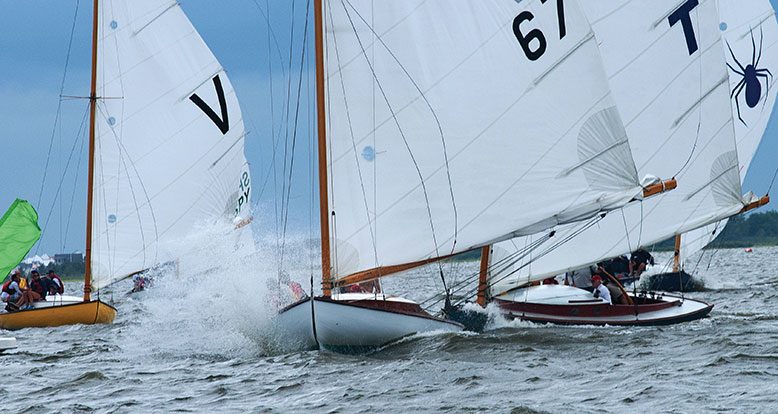
Some people sail for the quiet, some for the connection with the sea, and some just to get away from it all. Those who pilot historic A Cat sailboats on Barnegat Bay do it for the speed. They also enjoy sailing these rare boats on the same New Jersey waters where the boats first raced almost 100 years ago.
“We love it,” says Gary Stewart, “but also we see ourselves as caretakers of this tradition.” Stewart, a native of Toms River, and his partners, Roy Wilkins, Maggie Groff and Rich Yetman, own Spy, one of 13 A Cats still racing on the bay.
It is believed that only 18 A Cats were ever built. Handcrafted of wood, each A Cat is 28 feet long and sports a 46-foot mast and a 28-foot boom that carry 600 square feet of sail.
In truth, A Cats are not the biggest or fastest sailboats on the bay, but what they lack in speed is more than made up for in beauty—especially with their huge mainsails stretched hard to the wind. The boats evolved from working catboats that plied East Coast waters with passengers and freight for nearly 200 years.
Painstakingly constructed of cedar, ash, fir and spruce, A Cats take nearly 5,000 man-hours to build. The seven original A Cats built in the 1920s cost about $2,500. That was a lot of money at the time, but 93 years after the first one was launched, it continues to compete with boats constructed decades later.
“A Cats are special,” says John Brady, director of the Philadelphia Independence Seaport Museum, who built one of the new-generation A Cats. “They are special to build and to sail and, if given a chance, I’d build another one in a minute.”
A Cats require a crew of six to eight experienced sailors. They are especially challenging in a strong breeze. The skipper steers the boat with a long tiller, fighting to keep it close to the wind. The mainsheet tender—typically, a sailor of great physical strength—controls the boat’s long boom and huge sail without the help of the mechanical winches common on other racing boats. The remainder of the crew needs to be agile, leaning hard over the rail when the boat heels and moving swiftly in the front of the mast when the boat tacks.
The A Cat era started in 1922, when Charles McKeehan, a Philadelphia judge who summered at the Jersey Shore, commissioned yacht designer Charles D. Mower to build a boat to compete in the prestigious Toms River Challenge Cup. The prize: a majestic silver mug from Tiffany presented by the Toms River Yacht Club since 1871.
Mower designed a new breed of catboat with a low stance for stability, a shallow draft and a deep centerboard suitable for local waters. Built by the Morton Johnson boatyard in Bay Head, it had a modern Marconi sailing rig that was more efficient than the older Gaff rigs common on working boats. McKeehan named the boat Mary Ann after his mother. In her first season, Mary Ann fulfilled McKeehan’s dream of winning the cherished cup.
Sadly, the A Cats almost disappeared in the late 1970s. Four of the original seven remained, but were literally falling apart. At that point, two men stepped forward to keep the A Cats from passing into the history books, explains Chip Hillyer, the fleet’s current captain. Hillyer organizes A Cat events during the racing season.
Nelson Hartranft, a retired businessman from Ocean Gate, purchased the four boats before they were scrapped. Working with local boatbuilders, Hartranft restored the A Cats to sailing condition and sold them to skippers who were dedicated to racing. Incredibly, the original plans were discovered by a boatyard worker in a Toms River antique shop. That enabled Hartranft to build a new A Cat—the first in 60 years.
Hartranft’s new boat, which he dubbed Wasp, was constructed by master boatbuilder Lally Beaton at David Beaton & Son boatyard in Brick. Five more A Cats were built and sold in the 1990s by Peter Kellogg, a retired Wall Street trader who summers in Bay Head. (Kellogg owned the A Cat Lotus as a teenager in the 1930s.) Several more were constructed in New Jersey in 2001 and 2002—at a cost of about $250,000.
The A Cats race nearly 30 times a season—a huge time commitment for all involved—competing for series honors as well as historic yacht club trophies, many named for famous Barnegat Bay mariners. But more than the victories, the skippers savor the tradition. “We don’t want to see these A Cats disappear,” says Stewart.
You can see the A Cats for yourself from River Avenue in Toms River near the Island Heights Yacht Club (65 River Avenue). Informal races take place on Friday nights and Saturday afternoons throughout the summer.
Freelance writer/photographer Art Petrosemolo covers horse racing, sailboat racing and other action sports and events.



